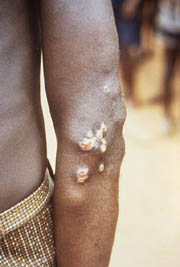Yaws: Cause, Symptoms, Diagnosis
and Treatment

Yaws is a tropical infection of the skin, bones and joints caused by the spirochete bacterium Treponema pertenue. The term yaws is thought to be of Caribbean origin. In the language of the Carib Indian people, yaya is the word for "a sore."
The disease is transmitted by skin contact with infected individuals or eye gnats, the spirochete entering through an existing cut or similar damage.
Yaws usually features lesions that appear as bumps on the skin of the face, hands, feet, and genital area. The disease most often starts as a single lesion that becomes slightly elevated, develops a crust that is shed, leaving a base that resembles the texture of a raspberry or strawberry. This primary lesion is termed the mother yaw. Secondary lesions, termed daughter yaws, develop in about six to 16 weeks after the primary lesion.
Yaws has four stages: primary, secondary, latent, and tertiary. The primary stage is the appearance of the mother yaw. Patients with yaws develop recurring ("secondary") lesions and more swollen lymph nodes. This represents the secondary stage. These secondary lesions may be painless like the mother yaw or they may be filled with pus, burst, and ulcerate. The affected child often experiences malaise (feels poorly) and anorexia (loss of appetite). The latent stage occurs when the disease symptoms abate, although an occasional lesion may occur. In the tertiary stage, yaws can destroy areas of the skin, bones, and joints and deform them. The palms of the hands and soles of the feet tend to become thickened and painful (crab yaws).
The largest group afflicted by yaws are children aged 6 to 10 years in tropical areas of the Americas, Africa, Asia or Oceania.
The disease is identified from blood tests or by a lesion sample through a darkfield examination under a microscope. Treatment is by a single dose of penicillin, erythromycin or tetracycline; recurrence or relapse is uncommon.
Yaws was nearly eradicated by a worldwide treatment program in the 1950s, which reduced the number of sufferers of yaws from an estimated 50 million to nearly zero. However, the World Health Organization reported in January 2007 that yaws is on the rise again, with roughly a half a million sufferers, mostly in poor, rural areas.
|